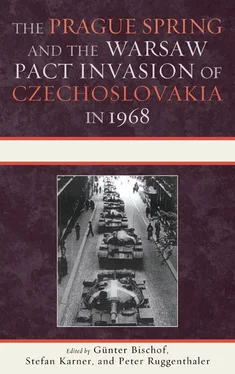On 22 July, the Soviet foreign minister, Marshal Grechko, was commissioned by the Politburo “to take measures.” At the same time, documents were drawn up in Moscow, “which had supposedly been written by the future leadership of the ČSSR, who should displace the current leaders.” 74At the July plenum of the Central Committee, Brezhnev had devised the contours of the Soviet approach during the action of collective assistance. In the event of doubt, an “initiative group” of “healthy forces” in the Presidium of the Central Committee of the KSČ would solicit assistance from abroad for the protection of socialism in the ČSSR. This “appeal” was the indispensable political prerequisite for the implementation of the military operation. In this way, as Brezhnev evidently hoped, the “measures” could be legitimized and lose their character of an intervention in the affairs of a sovereign state.
On 18 July, the GDR ambassador Florin announced from Prague that the Presidium of the KSČ had substantiated its “negative attitude” to the Warsaw Letter with the “principle of personal responsibility for domestic developments.” The course of the session had shown that the “Party leadership is still not prepared to engage in an energetic struggle, supported by the sister parties, against the counterrevolutionary activities.” 75In view of the approach of the Czechoslovak leadership, collective action became more and more probable. The SED began to prepare itself. The first measure was a resolution from the SED Politburo on 19 July to install a radio transmitter in the region of Dresden, which was to broadcast political information mornings and evenings in Czech and Slovak. As the technical equipment of GDR Radio was not sufficient, the mobile transmitter of GDR- Ferienwelle (GDR Holiday Wave) was used for this purpose. 76
The military preparations were complete. 77On GDR territory alone, 650,000 soldiers were mobilized. “Overall, the military concentration of the troops of the five ‘fraternal armies’ reached its highpoint on the borders of the ČSSR on 29 and 30 July. The intervention had become militarily possible; the Soviet generals awaited the political approval of the CPSU leadership.” 78The GDR was also prepared. On 29 July, the National Defense Council (NVR) had convened and received reports on the status of military preparations and those from the Interior Ministry and the MfS. 79When the Presidium of the KSČ met with that of the CPSU on 29 July in Čierna nad Tisou, the SED had completed the political and military preparations for the intervention in the ČSSR, but the SED like the Soviet generals also had to wait for the order to deploy.
The political preparation for the “collective actions” was significantly more complicated. The KSČ had a leadership chosen by the relevant party bodies and its reform program was widely approved within the Czechoslovakian population, including its insistence on barring interference from the Warsaw Five in the internal affairs of the ČSSR. A further problem for the Soviet leadership was that Dubček agreed internally with the criticism on the part of the CPSU of the approach of the “antisocialist forces,” but did not proceed against them. In short, the intervention required a political justification; it was most elegant when Dubček publicly committed himself to an agreement with the Warsaw Five and then failed to abide by it. When one takes all the CPSU’s points of criticism of developments in the ČSSR since January 1968 together, it was also clear to Brezhnev by the meeting in Warsaw at the latest that Dubček and his leadership would not bring about a change in the “counterrevolutionary process” on their own initiative. It seems, however, also to have been important to the CPSU general secretary to demonstrate this to the Communists in the ČSSR, in the Socialist states, and in the global movement. Perhaps he also still hoped to induce Dubček to “take the leap” in order to utilize his popularity for the politics of restoration—as indeed happened after the intervention.
There were thus reasons enough for his plan of continuing to want to search for a “political solution” with which he concluded his report to the Central Committee on 17 July. He affirmed that “before we resort to extreme measures,” the leadership at a bilateral meeting with the KSČ would still attempt to resolve this political solution. Its contents were known to Dubček and his Presidium since the Dresden meeting; the letter from the Warsaw Five had updated them.
The meeting began on 29 July; 80the Czechoslovakian railway border crossing to the Soviet Union, Čierna nad Tisou, had been selected as the venue. The Soviet Politburo met for the first time outside its national boundaries. The gathering lasted several days. In the end, the SED, BCP, PUWP, and HSWP were invited on 2 August by the CPSU to a meeting with the KSČ in Bratislava on the next day. During the negotiations, the CPSU had forced a series of conditions on the Czechoslovakian side in order to regulate the political issues: they were to win back control over the mass media and to prevent the activity of political clubs outside the National Front, as well as attempts to reestablish the Social Democratic Party. The changes in the cadre were serious: in the Presidium and the Central Committee, secretariat Česimír Císař and the chairman of the National Front, František Kriegel, were to lose their posts, as well as Interior Minister Josef Pavel and the director of state television, Jiří Pelikán. Viliam Šalgovič was again to assume leadership of state security. “Brezhnev insisted on these commitments and threatened, if they were not complied with, ‘we will come to your assistance’—evidently militarily.” 81
The gathering in Bratislava had one single aim: for the Warsaw Five and the KSČ to adopt a joint communiqué. Dubček accepted the Soviet draft as a basis for negotiations. 82
With regard to the future foreign policy of the ČSSR, the KSČ had prepared the formula of “exclusive responsibility of each country for socialism in their own country” for the 14th Party Congress, and with it justified the rejection of the letter of the Warsaw Five. 83In contrast, in Bratislava the KSČ signed a very different formula, namely that of the “mutual duty of all socialist countries to defend socialism. The Soviet side did not even allow the basic principle of non-intervention guaranteed by the bilateral alliance treaties.” 84Before the Central Committee of the SED, Hermann Axen, Central Committee Secretary for International Affairs, assessed it as a great success that the term nonintervention called for by the Czechoslovakian delegation was not included in the communiqué. 85As a member of the editorial commission, Ulbricht spoke out vehemently against the Czechoslovakian conception of the SPD as a “progressive force” in the Federal Republic and got the formulation accepted into the communiqué “that promised above all support to the [Communist Party of Germany, Kommunistische Partei Deutschlands ] KPD, which was banned in the Federal Republic.” 86Hence, in Bratislava the KSČ had agreed in the joint communiqué both to Socialist internationalism and to the renunciation of an individual path to socialism. If in the view of the Kremlin, the KSČ should break the agreements made, it had itself signed the political basis on which the “collective action” or the “brotherly assistance” could be legitimized.
On the fringes of the conference in Bratislava, the “initiative group” of the “healthy forces” announced by Brezhnev to his Central Committee, which was indispensable for the political justification of an intervention and for the day after, also finally made an appearance. Jan Pauer writes, “During the course of the Bratislava meeting, a plea, a letter was passed to the Soviet comrades, in which several members of the Presidium of the Central Committee of the KSČ and the government requested help from the Soviet leadership. It was stated in the letter that ‘should the situation continue to deteriorate and the accepted commitments not be fulfilled—the undersigned comrades would see no other option than international assistance from the allies, because we won’t get out of there on our own steam and there won’t be any more time for new negotiations.’ 87The letter was signed by five members of the KSČ Presidium and Secretariat, who took part in the negotiations in Čierna nad Tisou themselves. 88
Читать дальше












